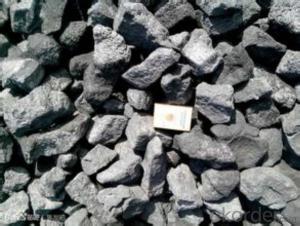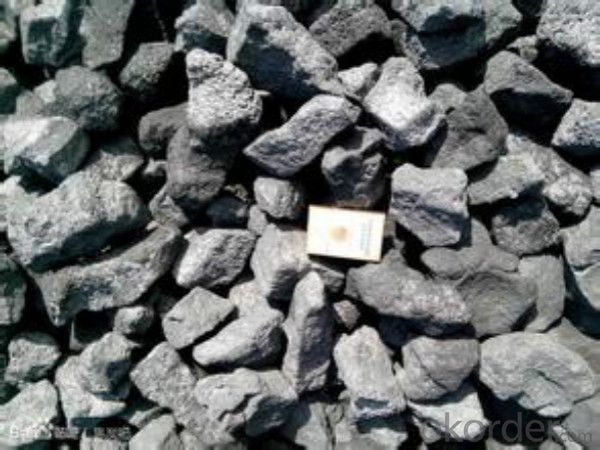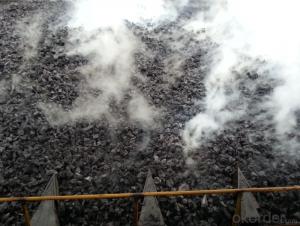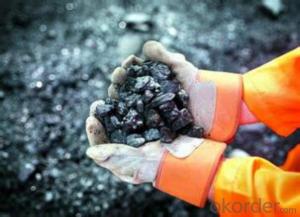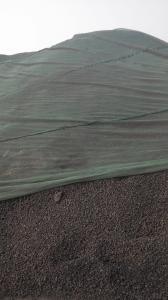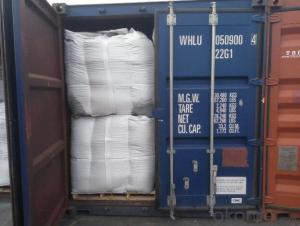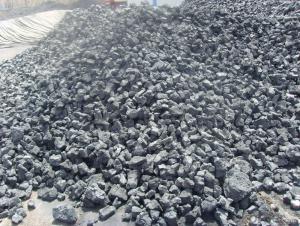30-80mm Low Ash 12.5%Met Coke for Steel Plant
- Loading Port:
- Tianjin
- Payment Terms:
- TT OR LC
- Min Order Qty:
- 1200 m.t.
- Supply Capability:
- 20000 m.t./month
OKorder Service Pledge
OKorder Financial Service
You Might Also Like
Product Description
Met Coke(metallurgical coke) is a carbon material resulting from the manufactured purification of multifarious blends of bituminous coal. In its natural form, bituminous coal is soft; its medium-grade composite contains a high occurrence of unstable components. The majority of the unstable components are either reclaimed or recycled.
Features
It is widely used in casting and metallurgy Smelting every tons Irons need about 0.4 to 0.6ton coke. As the reducing agent in the steel-making and foundry industry.
Specification
Item No. | Ash (%) max | S (%) max | F.C. (%) min | V.M (%) max | Moisture (%) max | P (%) max | CSR (%) min | CRI (%) max | Cal.Value (≥Kcal/Kg) |
NF-M001 | 9 | 0.6 | 89.5 | 1.2 | 5 | 0.035 | 65 | 25 | 7250 |
NF-M002 | 10.5 | 0.6 | 88 | 1.2 | 5 | 0.035 | 65 | 25 | 7100 |
NF-M003 | 12 | 0.6 | 86.5 | 1.5 | 5 | 0.035 | 63 | 28 | 6900 |
NF-M004 | 13 | 0.6 | 85.5 | 1.5 | 5 | 0.035 | 60 | 30 | 6800 |
Pictures
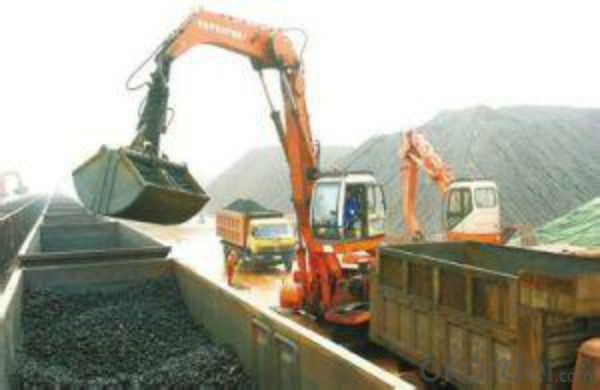
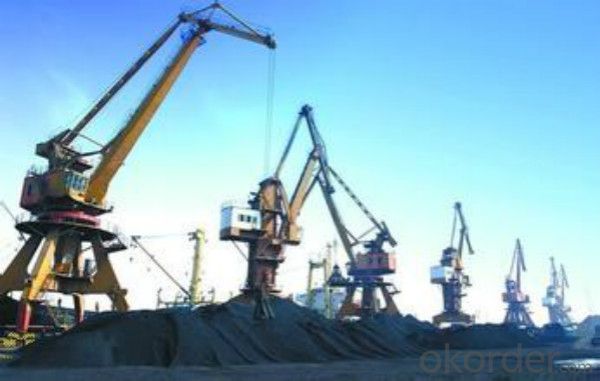
FAQ
1 What is the packing?
Packaging Details: | 1. jumbo ton bag |
2 Delivery time? Delivery Detail: |
15 days after we get the advanced payment or original L/C |
- Q: What are the impacts of carbon emissions on the stability of mountains?
- Carbon emissions can have various impacts on the stability of mountains. One significant effect is the acceleration of glacial melting, leading to increased water runoff and the potential for more frequent and severe landslides. Additionally, carbon dioxide contributes to the acidification of rainwater, which can corrode rocks and weaken the stability of mountain slopes. Climate change, driven by carbon emissions, also leads to alterations in precipitation patterns, temperature, and weather events, increasing the risk of erosion, rockfalls, and avalanches. Overall, carbon emissions have a detrimental influence on the stability of mountains, posing risks to both human populations and ecosystems.
- Q: How does a kebab cook at home?
- The string label used (as with oil, burning flammable), placed below, then take a layer without burning the child, put carbon. The main thing is to make a gap between the fire and carbon. Then from the stove below the fan, let the fire go.
- Q: What is carbon fixation in biology?
- The process of carbon fixation in biology involves the conversion of atmospheric carbon dioxide (CO2) into organic compounds by living organisms. This is a crucial step in the global carbon cycle and is primarily carried out by autotrophic organisms such as plants, algae, and certain bacteria. During the process of carbon fixation, the enzyme RuBisCO (ribulose-1,5-bisphosphate carboxylase/oxygenase) facilitates the reaction between CO2 and a five-carbon sugar molecule called ribulose bisphosphate (RuBP). This reaction produces two molecules of a three-carbon compound known as 3-phosphoglycerate (3-PGA). This initial step is referred to as the Calvin cycle or C3 photosynthesis. In plants, the 3-PGA molecules are then transformed into other organic compounds, including sugars, starches, and cellulose, through a series of enzymatic reactions. These organic compounds serve as the building blocks for the growth and development of the plant. Carbon fixation plays a crucial role in maintaining a balance of atmospheric CO2 levels and is a key process in regulating climate change. It allows for the transfer of carbon from the atmosphere to the biosphere, ultimately reducing the concentration of greenhouse gases and mitigating the impacts of global warming. Additionally, carbon fixation is essential for sustaining life on Earth as it forms the basis of food chains and supports the growth of other organisms. Heterotrophs, such as animals and humans, rely on the organic compounds produced by autotrophs through carbon fixation for their energy and nutritional requirements. In conclusion, carbon fixation is a fundamental biological process that facilitates the conversion of atmospheric carbon dioxide into organic compounds. It sustains life on Earth and aids in the regulation of the planet's climate.
- Q: Benefits of reducing carbon emissions
- 2, slow down the greenhouse effect. 1) the increase of diseases and insect pests on the earth;2) sea-level rise;3) the climate is abnormal and the ocean storm is increasing;4) the land was dry and the desertification area increased.Scientists predict that if the earth's surface temperature at the present rate of progress, by 2050 the global temperature will rise 2 to 4 degrees Celsius, the polar ice will melt significantly, resulting in a significant rise in sea level, some island countries and coastal city will be submerged in the water, which consisted of several famous international City: New York Shanghai, Tokyo and Sydney.The greenhouse effect can threaten prehistoric human beings with deadly virusesU.S. scientists recently warned that due to rising global temperatures to the Arctic ice melt, frozen hundreds of thousands of years of prehistoric deadly virus may lead to a global epidemic delivered from oppression, panic, human lives are threatened.Syracuse University of New York scientists in the latest issue of "scientists" magazine pointed out earlier, they found a plant virus TOMV, the virus spread widely in the atmosphere that has its traces in the Arctic ice.
- Q: What are the different types of carbon steel?
- Carbon steel, known for its strength, durability, and affordability, is widely utilized in various industries. It is a versatile material with multiple types, each possessing unique properties and applications. 1. Low Carbon Steel: This form of carbon steel contains a minimal amount of carbon, usually up to 0.25%. It is extensively used due to its affordability, ease of fabrication, and weldability. Low carbon steel finds applications in construction, automotive manufacturing, and general engineering. 2. Medium Carbon Steel: With a carbon content ranging from 0.25% to 0.60%, medium carbon steel offers increased strength and hardness compared to low carbon steel. It is commonly employed in machinery parts, axles, gears, and shafts that require enhanced toughness and wear resistance. 3. High Carbon Steel: High carbon steel contains a carbon content of 0.60% to 1.00%. It possesses excellent strength and hardness but is less ductile and more brittle than low and medium carbon steels. High carbon steel is frequently used in cutting tools, springs, and high-strength wires. 4. Ultra-High Carbon Steel: This type of carbon steel contains a carbon content exceeding 1.00%, typically ranging from 1.20% to 2.50%. It exhibits extremely high hardness and is often employed in specialized applications such as knives, blades, and tools that demand exceptional sharpness and wear resistance. 5. Carbon Tool Steel: Carbon tool steel refers to a group of steels that incorporate additional alloying elements like chromium, vanadium, or tungsten. These alloying elements enhance the steel's hardness, wear resistance, and heat resistance, making it suitable for tool and die making, cutting tools, and molds. It is important to note that the strength, hardness, and other properties of steel are determined by its carbon content. The selection of the appropriate type of carbon steel depends on the specific application, desired characteristics, and manufacturing requirements.
- Q: What are the impacts of carbon emissions on the stability of river ecosystems?
- The stability of river ecosystems is significantly affected by carbon emissions, which have various consequences. One of the main outcomes of carbon emissions is the rise in greenhouse gases in the atmosphere, resulting in global warming. This increase in temperature directly and indirectly impacts river ecosystems. To begin with, higher temperatures can modify the physical characteristics of rivers and impact the availability of oxygen in the water. Warmer water holds less dissolved oxygen, which can be harmful to aquatic organisms like fish and invertebrates that depend on oxygen for survival. The decrease in oxygen levels can lead to a decrease in biodiversity and even cause fish to die. Furthermore, climate change caused by carbon emissions can disrupt the natural hydrological cycle. Changes in precipitation patterns can lead to droughts or floods, causing fluctuations in river flow. These alterations can affect the reproductive and migration patterns of many aquatic species, disturbing their life cycles and reducing their populations. Additionally, modified river flows can also affect the stability of riverbank and riparian habitats, resulting in erosion and habitat loss. Moreover, increased carbon emissions contribute to ocean acidification. When water absorbs carbon dioxide, it forms carbonic acid, which lowers the pH of the water. Acidic waters can have harmful effects on aquatic life, including shellfish, corals, and other organisms that calcify. River ecosystems are interconnected with coastal and marine ecosystems, so the consequences of ocean acidification can indirectly impact river ecosystems through the food chain. Furthermore, carbon emissions contribute to the deposition of air pollutants, such as nitrogen and sulfur compounds, onto land and water bodies. These pollutants can be carried by rainfall into rivers, leading to increased nutrient levels and eutrophication. Excessive nutrients can cause harmful algal blooms, deplete oxygen levels, and create dead zones, further disturbing the balance of river ecosystems. In conclusion, the stability of river ecosystems is profoundly impacted by carbon emissions. Rising temperatures, altered hydrological cycles, ocean acidification, and increased nutrient levels all contribute to the degradation of these ecosystems. It is essential to reduce carbon emissions and adopt sustainable practices to mitigate these impacts and preserve the health and stability of river ecosystems.
- Q: How is activated carbon produced?
- Activated carbon is produced through a process called activation, which involves heating carbon-rich materials, such as wood, coal, or coconut shells, at high temperatures in the absence of oxygen. There are two main methods of activation: physical activation and chemical activation. In physical activation, the carbon-rich material is first carbonized by heating it to a high temperature. This creates a carbonized char with a high carbon content. The char is then treated with an oxidizing gas, such as steam or carbon dioxide, at temperatures between 600 to 900 degrees Celsius. This causes the char to expand and develop a highly porous structure. The resulting material is then washed and dried to remove any impurities, resulting in activated carbon. Chemical activation, on the other hand, involves impregnating the carbon-rich material with a chemical activating agent, such as phosphoric acid, zinc chloride, or potassium hydroxide. The impregnated material is then heated to temperatures ranging from 400 to 800 degrees Celsius. This process chemically reacts with the carbon, creating a highly porous structure. The activated carbon is then washed and dried to remove any residual chemicals. Both physical and chemical activation methods result in the production of activated carbon with a large surface area and a network of pores. These pores enhance the adsorption capacity of the activated carbon, allowing it to effectively trap and remove impurities, contaminants, and pollutants from gases and liquids.
- Q: What are the effects of carbon emissions on the stability of the atmosphere?
- Carbon emissions have significant effects on the stability of the atmosphere. Increased levels of carbon dioxide and other greenhouse gases contribute to the greenhouse effect, trapping heat within the atmosphere and leading to global warming. This results in various consequences such as rising temperatures, changes in weather patterns, melting ice caps, and rising sea levels. These alterations disrupt the delicate balance of the atmosphere, causing severe environmental and ecological impacts, including more frequent and intense extreme weather events. Ultimately, carbon emissions threaten the stability of the atmosphere and the overall health of our planet.
- Q: Whether the CO2 content in the boiler smoke can not be measured, the measurement of carbon content of fly ash ah? @ @ Thank you very much!!!
- Just like oxygen measuring zirconia, the CO2 content has a specialized CO2 sensor that can be measured directly
- Q: How does carbon impact the quality of freshwater systems?
- Carbon can impact the quality of freshwater systems in various ways. Carbon dioxide (CO2) dissolved in water can lower its pH, leading to increased acidity and potentially harming aquatic organisms. Additionally, excessive carbon inputs from human activities like the burning of fossil fuels can contribute to eutrophication, causing algal blooms and depleting oxygen levels in water bodies, further compromising the health of freshwater ecosystems.
Send your message to us
30-80mm Low Ash 12.5%Met Coke for Steel Plant
- Loading Port:
- Tianjin
- Payment Terms:
- TT OR LC
- Min Order Qty:
- 1200 m.t.
- Supply Capability:
- 20000 m.t./month
OKorder Service Pledge
OKorder Financial Service
Similar products
Hot products
Hot Searches
